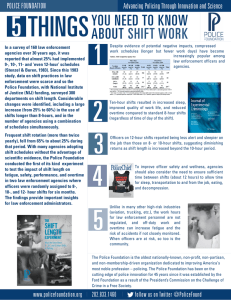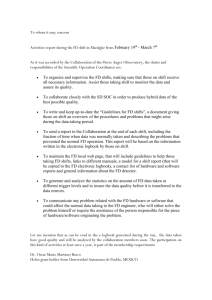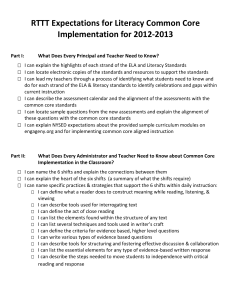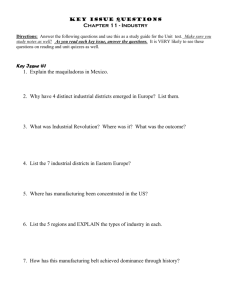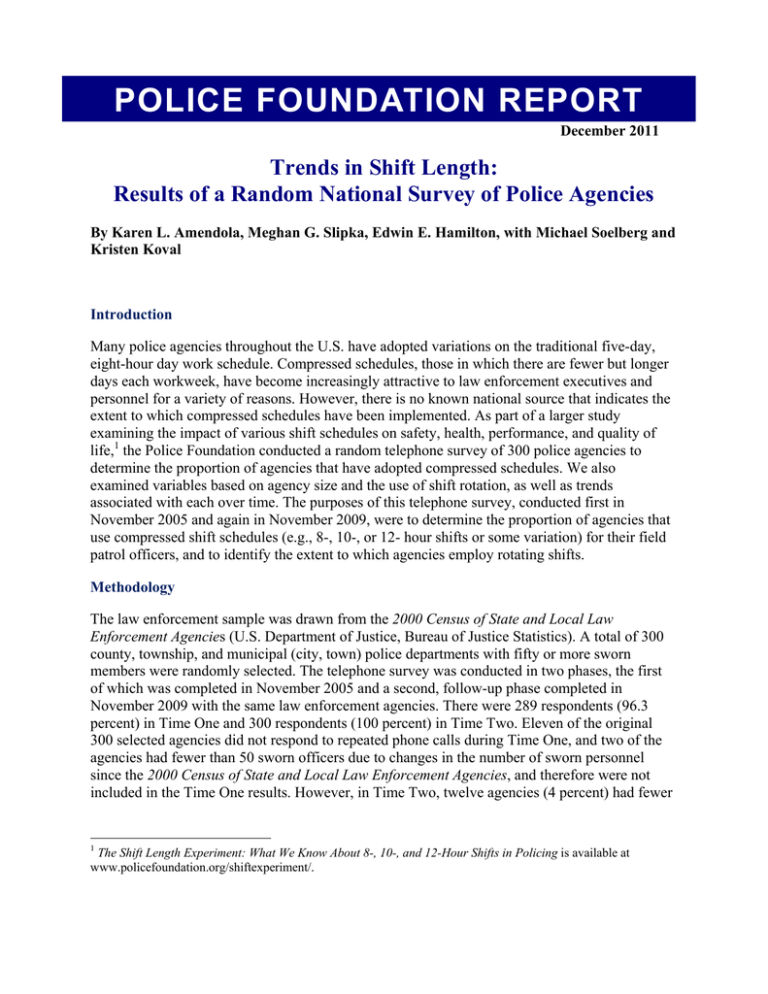
POLICE FOUNDATION REPORT
December 2011
Trends in Shift Length:
Results of a Random National Survey of Police Agencies
By Karen L. Amendola, Meghan G. Slipka, Edwin E. Hamilton, with Michael Soelberg and
Kristen Koval
Introduction
Many police agencies throughout the U.S. have adopted variations on the traditional five-day,
eight-hour day work schedule. Compressed schedules, those in which there are fewer but longer
days each workweek, have become increasingly attractive to law enforcement executives and
personnel for a variety of reasons. However, there is no known national source that indicates the
extent to which compressed schedules have been implemented. As part of a larger study
examining the impact of various shift schedules on safety, health, performance, and quality of
life,1 the Police Foundation conducted a random telephone survey of 300 police agencies to
determine the proportion of agencies that have adopted compressed schedules. We also
examined variables based on agency size and the use of shift rotation, as well as trends
associated with each over time. The purposes of this telephone survey, conducted first in
November 2005 and again in November 2009, were to determine the proportion of agencies that
use compressed shift schedules (e.g., 8-, 10-, or 12- hour shifts or some variation) for their field
patrol officers, and to identify the extent to which agencies employ rotating shifts.
Methodology
The law enforcement sample was drawn from the 2000 Census of State and Local Law
Enforcement Agencies (U.S. Department of Justice, Bureau of Justice Statistics). A total of 300
county, township, and municipal (city, town) police departments with fifty or more sworn
members were randomly selected. The telephone survey was conducted in two phases, the first
of which was completed in November 2005 and a second, follow-up phase completed in
November 2009 with the same law enforcement agencies. There were 289 respondents (96.3
percent) in Time One and 300 respondents (100 percent) in Time Two. Eleven of the original
300 selected agencies did not respond to repeated phone calls during Time One, and two of the
agencies had fewer than 50 sworn officers due to changes in the number of sworn personnel
since the 2000 Census of State and Local Law Enforcement Agencies, and therefore were not
included in the Time One results. However, in Time Two, twelve agencies (4 percent) had fewer
1
The Shift Length Experiment: What We Know About 8-, 10-, and 12-Hour Shifts in Policing is available at
www.policefoundation.org/shiftexperiment/.
than 50 sworn officers. Despite this, we included the data from these twelve agencies in our
analysis because they previously had reported having 50 or more sworn officers in Time One.
As shown in Table 1, for Time One, a total of 57.1 percent of the respondents were from smaller
agencies (50 to 100 sworn officers), which decreased to 52.3 percent in Time Two. There was
almost no change in the number of medium-size agencies with 101 to 200 sworn officers, 28.4
percent in Time One and 28.7 percent in Time Two. Large agencies, with 201 or more sworn
officers, made up 13.8 percent of the respondents in Time One and 15 percent in Time Two.
Table 1. Distribution of Respondents
Number of Sworn Officers
a
b
Number of Responding Agencies (%)
Time One
Time Two
November 2005
November 2009
< 50
2 (0.7) a
12 (4.0) b
50 to 100
(small)
165 (57.1)
157 (52.3)
101 to 200
(medium)
82 (28.4)
86 (28.7)
201 +
(large)
40 (13.8)
45 (15.0)
Total
289
300
These 2 agencies were not included in our analysis.
These 12 agencies had fewer than 50 officers at the Time Two survey.
Results
Shift Length 2
Over the four-year period, the biggest change in shift schedules was the movement away from
traditional 8-hour shift schedules, from 40.1 percent in 2005 to 29.3 percent in 2009. There were
minor changes in the 10- and 12-hour shifts; for the 10-hour, the drop was from 27 percent to 22
percent, whereas the 12-hour shift showed a slight increase from 24 percent to 26 percent as
shown in Table 2.
2
Actual shift lengths were reported by departments, and we applied rounding as follows: schedules of 7.5 to 8.4
hours were classified as 8-hour tours; 8.5 to 9.4-hour tours were considered 9-hour shifts; 9.5 to 10.4 were
considered 10-hour shifts; 10.5 to 11.4 were considered 11-hour shifts; 11.5 to 12.4 were considered 12-hour shifts;
and those with 12.5 to 13.4 were considered 13-hour shifts. There were no agencies that reported schedules of 13.5
or more hours.
________________________________________________________________________________________________
Trends in Shift Length
Police Foundation Report
Page 2
December 2011
During Time One, the most prevalent shift length across all agencies was the traditional 8-hour
shift (40.1 percent), followed by the 10-hour shift (27.2 percent) and, lastly, the 12-hour shift (24
percent). The less traditional schedules (9-hour and 11-hour shifts) were less common, though
these two shifts combined accounted for 2.7 percent of the overall shift schedules in 2005. The
less traditional workdays became more common by 2009, with a total of 11.3 percent of agencies
adopting 9-, 11-, and even 13-hour schedules.
Table 2. Shift Length by Agency Size
Time One
November 2005
Time Two
November 2009
8 HR
10 HR 12 HR
8 HR
10 HR 12 HR
Number
Agencies Agencies Agencies Total Agencies Agencies Agencies Total
Sworn Officers
(%)
(%)
(%)
(%)
(%)
(%)
50 to 100
(small)
68
(41.2)
37
(22.4)
47
(28.5)
152
54
(32.0)
33
(19.5)
52
(30.8)
139
101 to 200
(medium)
34
(41.5)
27
(32.9)
16
(19.5)
77
23
(26.7)
19
(22.1)
22
(25.6)
64
201 +
(large)
13
(32.5)
14
(35.0)
6
(15.0)
33
11
(24.4)
15
(33.3)
5
(11.1)
31
Total
115
(40.1)
78
(27.2)
69
(24.0)
262 a
88
(29.3)
67
(22.3)
79
(26.3)
234 b
a
For Time One, there were a total of 5 (1.7 percent) agencies with 9-hour shifts and 3 (1 percent) agencies with 11hour shifts; 17 (5.9 percent) agencies employed multiple shifts.
b
For Time Two, there were 14 (4.7 percent) agencies with 9-hour shifts and 16 (5.3 percent) agencies with 11-hour
shifts; 4 (1.3 percent) agencies employed 13-hour shifts and 32 (10.7 percent) agencies employed multiple shifts.
Multiple shifts. Our survey showed that a small proportion of agencies (5.9 percent) employed
multiple shift lengths for their patrol officers in Time One. Additionally, there was an overall
increasing trend toward the adoption of multiple shift lengths for patrol officers in Time Two
(10.7 percent). Of the agencies reporting the use of multiple shifts (n=32), almost three-fourths
(71.9 percent) did not provide information about how they implemented these shifts. Two
agencies (6.3 percent) reported employing shorter shift lengths during midnight shifts, whereas
three (9.4 percent) reported longer, 10-hour shifts during the midnight shift. The remaining four
agencies (12.5 percent) that used mixed shifts had unique systems as follows:
1. Four 10-hour shifts Monday through Thursday or three 12-hour shifts for Friday
through Sunday shifts.
________________________________________________________________________________________________
Trends in Shift Length
Police Foundation Report
Page 3
December 2011
2. 8.5-hour shifts3 for most officers, testing 10-hour shifts in some districts.
3. 12-hour shifts for most officers are run during the summer months. The rest of the
year commanders can implement 8-, 10-, or 12- hour shifts at their discretion.
4. Alternating 8- and 16-hour shifts over a two-week period as follows: 8 hours on, 8
hours off; 16 hours on, 16 hours off; 8 hours on, and so on. This averages 48
hours in week one and 32 hours in week two.
Shift Length by Agency Size
As shown in Table 2, in both Time One and Time Two the most prevalent shift for the largest
agencies was the 10-hour shift (35 percent and 33.3 percent, respectively), whereas the 8-hour
shift was the most prevalent among the smaller agencies (41.2 percent and 32 percent,
respectively). However, smaller agencies were also more likely to adopt 12-hour shifts in both
Time One (28.5 percent) and Time Two (30.8) than were medium (19.5 percent, 25.6 percent) or
larger agencies (15 percent, 11.1 percent). While the most prevalent shift for medium-size
agencies was the 8-hour in 2005 (41.5 percent), by 2009 there was almost an equal distribution
of 8-hour (26.7 percent) and 12-hour (25.6 percent) shifts, with 10-hour shifts following closely
behind (22.1 percent). The fact that both small and medium agencies now have a fairly equal
distribution of 8-hour and 12-hour shifts is perhaps due to the ease of dividing a 24-hour period
into three 8-hour tours or two 12-hour tours. The use of 10-hour shifts by large agencies
remained fairly consistent over time.
Shift Rotation
Given the extent of research suggesting negative impacts of rotating shifts, we were surprised to
find that in 2005 the use of rotating shifts was still a common practice (46 percent), particularly
in smaller agencies (52.1 percent). However, we found that the larger the agency, the less likely
they were to employ rotating shifts (41.5 percent for medium agencies and 30 percent for larger
agencies). Over the four-year period between Time One and Time Two, the percentage of
agencies with rotating shifts declined by almost half from 46 percent in 2005 to 24.7 percent in
2009 (see Table 3). Similarly, there was an increase (about 40 percent) in fixed shifts from 54
percent to 75.3 percent, a trend that seemed most apparent in small and medium-sized agencies.
As of 2009, the use of rotating shifts was somewhat more common among smaller and midsize
agencies (25.2 percent and 26.3 percent, respectively), as compared to larger agencies (20.5
percent). These reductions may be due to an increasing awareness of research showing that shift
rotation can disrupt circadian cycles and result in greater fatigue, insomnia, or other health
problems (e.g., Colligan, Frockt, and Tasto 1979; Czeisler, Moore-Ede, and Coleman 1982), and
worker errors and accidents (e.g., Gold et al. 1992). Furthermore, by 2009, we saw the advent of
the use of both fixed and rotating schedules in agencies (4.3 percent).
3
Translated in our findings as a 9-hour shift.
________________________________________________________________________________________________
Trends in Shift Length
Police Foundation Report
Page 4
December 2011
Table 3. Number of Agencies with Fixed or Rotating Shifts
Fixed
Shift
Time One
November 2005
Rotating
Shift
Agencies
(%)
Agencies
(%)
50 to 100
79
(47.9)
86
(52.1)
101 to 200
48
(58.5)
201 +
Total
Number
Sworn
Officers
Total
Time Two
November 2009
Fixed
Rotating
Shift
Shift
Total
Agencies
(%)
Agencies
(%)
165
122
(74.8)
41
(25.2)
163 a
34
(41.5)
82
59
(73.8)
21
(26.3)
80
28
(70.0)
12
(30.0)
40
35
(79.5)
9
(20.5)
44
155
(54.0)
132
(46.0)
287
216
(75.3)
71
(24.7)
287 b
a
This includes the 12 agencies in which there were originally 50 or more officers, but that now have fewer than 50.
In Time Two, there were 13 (4.3 percent) agencies that had both fixed and rotating shift schedules. In Time One,
no agencies reported having both fixed and rotating shifts.
b
Conclusion
In summary, over the past several years many agencies have abandoned the 8-hour work
schedule in favor of alternatives. Nevertheless, the largest agencies have continued to
demonstrate a preference for 10-hour shifts during the same period. However, the proportion of
medium-sized agencies with 10-hour shifts dropped during the same period as did those with 8hour shifts, with an increasing number of those agencies opting for 12-hour shifts. An increase in
the use of multiple shifts, or shifts of differing lengths (9-, 11-, or 13-hours), during this period
may suggest that agencies lack information regarding the efficacy of various shift configurations
and/or are attempting to balance their needs with officer needs or preferences. Indeed, the period
from 2005 to 2009 was one of transition with regard to shift scheduling in American policing.
While agencies seem to have heeded the well-documented warning signs associated with shift
rotation, there has been substantially less information available to agencies regarding the pros
and cons of various shift lengths. During the period of this survey, the Police Foundation
conducted an experimental study of the impacts of 8-, 10-, and 12-hour shifts on various
individual and organizational outcomes. That study, The Shift Length Experiment: What We
Know About 8-, 10-, and 12-Hour Shifts in Policing4 (Amendola, Weisburd, Hamilton, Jones,
and Slipka 2011), should begin to bridge the gap in knowledge regarding the impact of various
shift schedules.
4
Available at www.policefoundation.org/shiftexperiment/.
________________________________________________________________________________________________
Trends in Shift Length
Police Foundation Report
Page 5
December 2011
References
Amendola, K. L., Weisburd, D., Hamilton, E., Jones, G., and Slipka, M. 2011. The Shift Length
Experiment: What We Know About 8-, 10-, and 12-Hour Shifts in Policing. Washington,
DC: Police Foundation. www.policefoundation.org/shiftexperiment/.
Colligan, M. J., Frockt, I. J., and Tasto, D. L. 1979. Frequency of sickness absence and worksite
clinic visits among nurses as a function of shift. Applied Ergonomics, 10(2), 79-85.
doi:10.1016/0003-6870(79)90058-9
Czeisler, C. A., Moore-Ede, M. C., and Coleman, R. M. 1982. Rotating shift and work schedules
that disrupt sleep are improved by applying circadian principles. Science, 217(4558),
460-463. doi:10.1126/science.7089576
Gold, D. R., Rogacz, S., Bock, N., Tosteson, T. D., Baum, T. M., Speizer, F. E., and Czeisler, C.
A. 1992. Rotating shift work, sleep, and accidents related to sleepiness in hospital nurses.
American Journal on Public Health, 82(7), 1011-1014. doi:10.2105/AJPH.82.7.1011
U.S. Department of Justice, Bureau of Justice Statistics. 2000. Census of State and Local Law
Enforcement Agencies (CSLLEA), 2000 (Database). Retrieved from
http://dx.doi.org/10.3866/ICPSR03484.v4
© 2011 Police Foundation. All rights reserved.
The Police Foundation Report series is available online at http://www.policefoundation.org/docs/library.html
This project was supported by award 2005-FS-BX-0057 from the National Institute of Justice,
Office of Justice Programs, U.S. Department of Justice. Points of view or opinions contained
in this document are those of the authors and do not necessarily represent the official position
or policies of the U.S. Department of Justice.
________________________________________________________________________________________________
Trends in Shift Length
Police Foundation Report
Page 6
December 2011
About the Police Foundation
The Police Foundation is a national, nonpartisan, nonprofit organization dedicated to supporting
innovation and improvement in policing. Established in 1970, the foundation has conducted
seminal research in police behavior, policy, and procedure and works to transfer to local agencies
the best information about practices for dealing effectively with a range of important police
operational and administrative concerns.
Our purpose is to help the police be more effective in doing their job. To accomplish our
mission, we work closely with police officers and police departments across the country, and it is
in their hard work and contributions that our accomplishments are rooted.
The foundation helps police departments to acquire both the knowledge gained through research
and the tools needed to integrate that knowledge into police practices. Working with law
enforcement agencies seeking to improve performance, service delivery, accountability, and
community satisfaction with police services, the foundation offers a wide range of services and
expertise.
The foundation has done much of the research that led to a questioning of the traditional model
of professional law enforcement and toward a new view of policing—one emphasizing a
community orientation. Sometimes, foundation research findings have challenged police
traditions and beliefs. For example, when police agencies employed routine preventive patrol as
a principal anti-crime strategy, a landmark foundation experiment in Kansas City showed that
routine patrol in marked patrol cars did not significantly affect crime rates. To address the
intense debate about how police should respond to incidents of domestic violence, the foundation
conducted the Minneapolis Domestic Violence Experiment—the first scientifically controlled
test of the effects of arrest for any crime.
The foundation has encouraged the creation of new forums for the debate and dissemination of
ideas to improve American policing, and helped create independent organizations dedicated to
the advancement of policing, including the Police Executive Research Forum, the National
Organization of Black Law Enforcement Executives, and the Police Management Association.
A guiding tenet of the foundation is that to advance, policing—like other public services—
deserves the best of thorough, objective study, and the impetus of new ideas that have the widest
possible dissemination. Foundation research findings are published as an information service and
are widely used in college, university, and law enforcement training classrooms in the U.S. and
abroad.
Independent and unconstrained by partisan imperatives, the Police Foundation speaks with a
unique and objective voice. Our focus and perspective is the whole of American policing, rather
than any single facet.
Motivating all of the foundation’s efforts is the goal of efficient, effective, humane policing that
operates within the framework of democratic principles and the highest ideals of the nation.
1201 Connecticut Avenue, NW
Washington, DC 20036-2636
(202) 833-1460 (202) 659-9149 fax
E-mail: pfinfo@policefoundation.org
www.policefoundation.org

